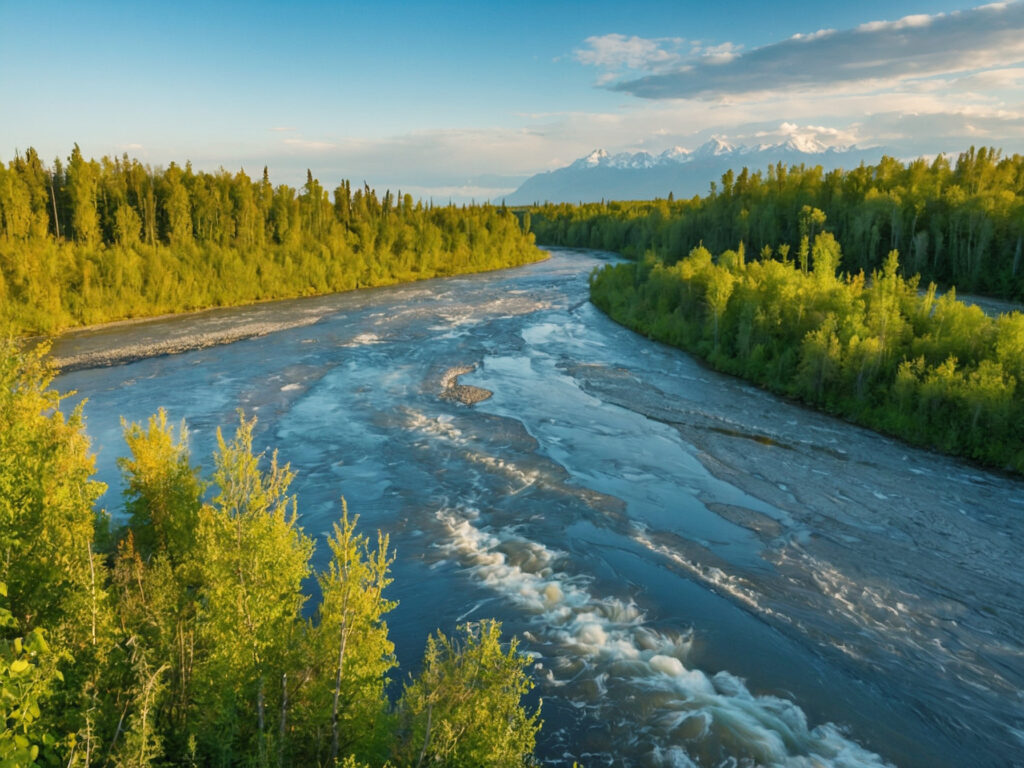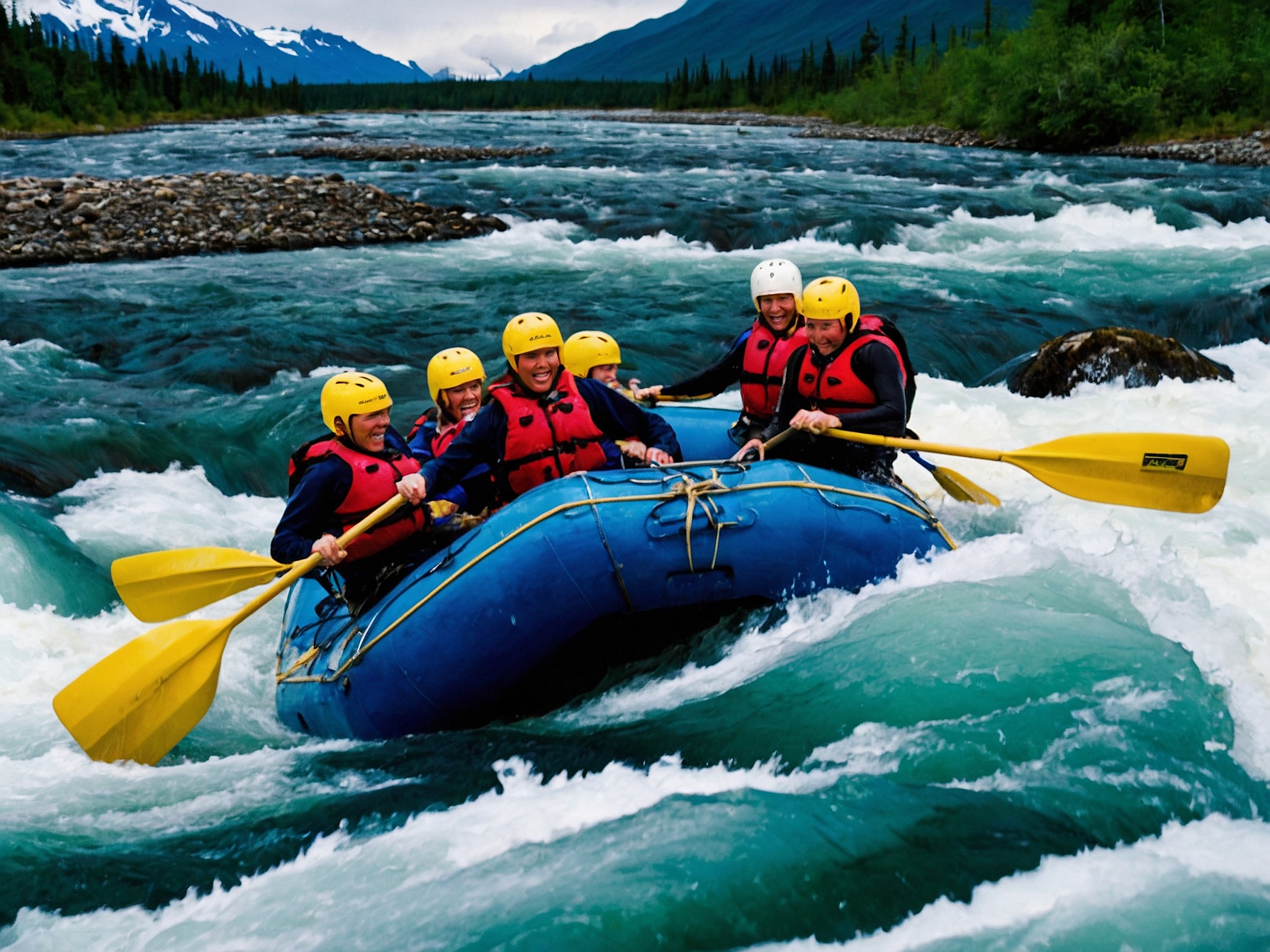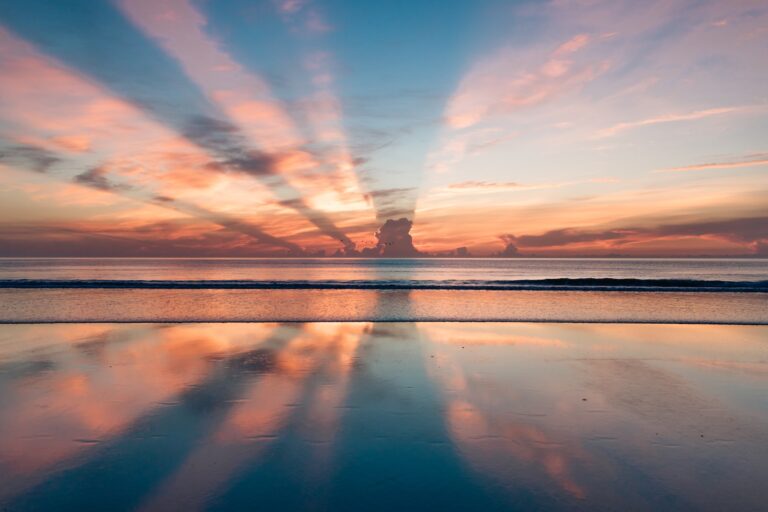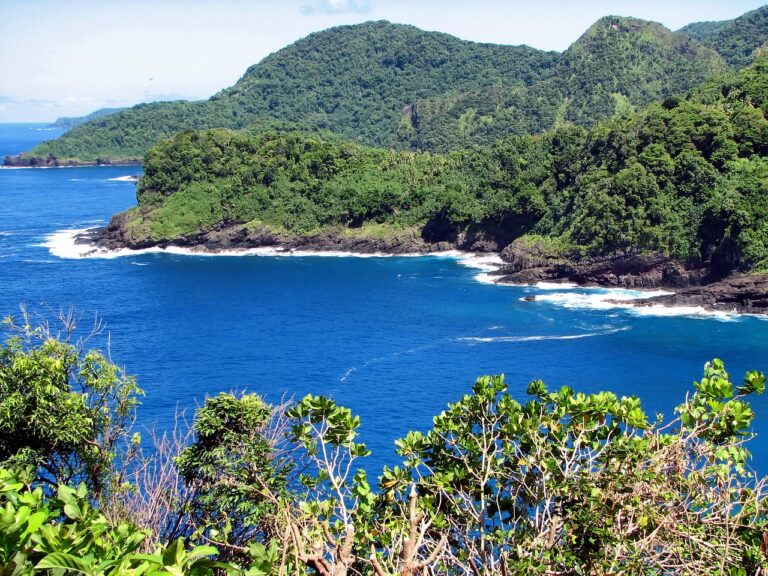White Water Rafting in Alaska’s Untamed Rivers
Welcome, adventurers! Looking for your next adrenaline-fueled experience? Alaska is waiting for you with its untamed rivers and breathtaking landscapes. Out here, white water rafting isn’t just a sport, it’s an adventure of a lifetime. Whether you’re a seasoned thrill-seeker or a curious novice, white water rafting in Alaska offers rapids for all skill levels. We’ll guide you through the majestic Alaskan waterways, discuss the best seasons to visit, delve into top-notch rafting locations, and arm you with essential safety tips. Let’s set off on this exhilarating journey together!
You’re about to enter into the wild unknown, a place of pristine waters and towering peaks. Why Alaska, you ask? Well, with its wealth of rivers coursing through stunning landscapes, Alaska is a white water rafter’s paradise.
- Keen to take on the waves? We’ll provide an overview of the varying levels of white water rafting available in Alaska.
- Curious about the perfect timing? We’ll help you uncover the best seasons for an unforgettable rafting experience.
- Wondering about the hot spots? Our guide covers the most sensational locations for white water rafting in Alaska.
- Got a keen eye for safety? Excellent! So do we. We’ll equip you with crucial safety tips for navigating Alaska’s white waters.
So grab your paddles and fasten your life vests—it’s time to dive into the detail of what white water rafting in Alaska truly entails!
Unpacking the Thrill of White Water Rafting in Alaska
Picture this: You’re sitting in a raft, your heart thumping in anticipation, as you embark on one of Alaska’s many swiftly moving rivers. Everything around you is a picture of raw, natural beauty untouched by humanity. The azure sky overhead, the rugged landscape and the crystal clear water below, all set the stage for an adventure that promises not just thrills but a deep and profound connection with nature. Welcome, dear reader, to the electrifying world of white water rafting in Alaska!
Now, you may ask: Why Alaska? The answer is really quite simple. Alaska, with its numerous rivers and diverse landscapes, offers an unparalleled white water rafting experience. From serene flat-water floats to high-adrenaline river runs, there is something for everyone here. Be it beginners looking to dip their feet into the refreshing yet challenging world of white water rafting, or seasoned adventurers seeking the thrill of conquering another untamed river, Alaska is sure to deliver.
Additionally, white water rafting in Alaska also offers a unique opportunity to witness and savor the state’s abundant natural beauty and wildlife. Expect to come face-to-face with eagles, bears, and moose, amongst others. The scenery that unfolds right in front of your eyes – the snow-capped mountains, the extensive forests, the majestic glaciers – is also simply breathtaking. And the best part? You get to enjoy all this while navigating the thrilling waves, feeling the rush of adrenaline, and challenging your body and mind like never before.
In short, white water rafting in Alaska is not just about the sport, it’s about the entire package – the landscape, the wildlife, and the unforgettable experience. So, whether you are an adventure junkie or a tranquility seeker, white water rafting in Alaska is calling you!
When to Hit the Waves: Best Seasons for White Water Rafting in Alaska
Ever wonder when’s the best time to experience the untamed, roaring waters of Alaskan rivers? Well, it all comes down to timing it right. The prime season for white water rafting in Alaska typically runs from May through September. But remember, each season brings its own unique flair to your adventure, affecting both the water levels and wildlife sightings.
Spring Rafting: Embrace the Chill
Come late May, as the winter snow begins to melt, rivers are replenished and provide some of the best white water experiences. The waters will be colder and the rapids wilder, but for adrenaline junkies looking for high-intensity thrills, this is your season. However, bear in mind to pack appropriate gear, such as dry suits and thermal layers, to keep warm.
Summer Rafting: Bask in the Sunshine
Peak rafting season falls in July and August. During these warmer months, river levels may drop, but don’t be deceived into thinking this makes for an easy ride. The reduced water levels can expose rocks and create more technical rapids to navigate. Bonus? Ample sunlight for up to 22 hours a day will provide stunning vistas illuminated in the golden glow of Alaskan summer days.
Fall Rafting: Savor the Serenity
September marks a shift to quieter waters, as the summer rush slows down. The breath-taking autumn foliage transforms the scenic backdrop into a riot of colors. Consider this season if you prefer a more serene experience. Lower water levels often mean fewer rapids, making it an ideal time for beginners or those seeking a calm, picturesque float trip.
In conclusion, choosing the right season for your Alaska white water rafting adventure largely depends on your comfort level with weather conditions, water temperature, and river intensity. One thing is certain though – each season proffers its own unique charm, making Alaska a rafting destination for all times.
Top Destinations: Alaska’s Premium White Water Rafting Locations
Alaska, with its rich topography and bountiful rivers, offers a plethora of impressive spots for white water rafting. Depending on your experience level and adventure appetite, you could pick from a variety of locations, each with its own unique charm. Let’s explore the cream of the crop.

Talkeetna River
First on the list is the exhilarating Talkeetna River. Known for its Class III and IV rapids, this river promises an adrenaline-pumping ride. You’ll not only test your rafting skills but also soak in some stunning Alaskan scenery including the majestic Mt. Denali, often visible on the horizon.
Six Mile Creek
If you crave higher stakes, head to Six Mile Creek in the Chugach National Forest. One of Alaska’s most challenging white water rivers, it features Class IV and V rapids. Remember, this spot is only recommended for seasoned rafters, given the intensity of the rapids and rigorous maneuvering required.
Knik River
For families and beginners, the placid waters of the Knik River serve up a gentler rafting experience. While catering to your safety-first approach, this river doesn’t skimp on the scenic quotient, showcasing awe-inspiring views of towering glaciers and diverse wildlife.
Whichever location you pick, ensure you are well-prepared with essential gear, proficient guidance, and an indomitable spirit to enjoy the best of white water rafting in Alaska.
Safety First: Essential Tips for White Water Rafting in Alaska
Before you board your raft, it’s crucial to understand that safety is paramount. Alaska’s wild rivers and changing weather conditions are more than enough to challenge even the most experienced adventurers. So, let’s gear up with some essential safety tips.
Listen to Your Guide: Your guide lives and breathes these frothy white waters. They know the river currents, the hidden rocks, and how to react in an emergency. Pay close attention to their instructions and follow their lead. Remember that it’s not just your safety at stake, but the whole rafting team’s.
Wear a Life Jacket: Even if you’re an excellent swimmer, don’t underestimate the power of Alaska’s wild rivers. Always wear a life vest. It must fit snugly and be properly buckled. Your guide will assist you in ensuring a correct fit as part of the safety briefing.
Wear Appropriate Clothing: The water temperature in Alaska can be unforgiving, and hypothermia is a real risk. Dress in layers, prefer water-resistant apparel, and never forget to wear a helmet. When the waves come crashing, you’ll be glad you’re wearing your gear.
Stay in the Boat: Yes, it might seem like common sense, but in the heat of the moment, some adventurous souls might consider a dip. Unless your guide instructs you otherwise, stay in the raft. If you fall out, hold onto your paddle, stay calm, and wait for rescue.
Respect the River: Never underestimate the power of the water. Rapid classifications can change in seconds, and what seems like a placid river can show its teeth. Listen to your guide, respect their experience, and understand that everything they do is for your safety.
Remember, preparation and precaution are keys to a safe and thrilling Alaskan white water rafting adventure.
Health and Fitness Requirements for White Water Rafting
Before embarking on your white water rafting adventure in Alaska, it’s crucial to ensure you meet certain health and fitness requirements. While white water rafting is open to everyone, from amateurs to seasoned enthusiasts, it does require a degree of physical fitness and good health. So let’s discuss what you need to consider.
First and foremost, stamina is key. A day out on the river can be taxing on the body, so you’ll need plenty of endurance to paddle your way through the rapids. Regular cardiovascular exercise before your rafting trip can help prepare your body for the challenge.
Strength, particularly upper body strength, is also important. Much of the movement in white water rafting involves using your arms to paddle and, at times, you may need to pull yourself or others to safety. Incorporating strength training exercises into your fitness regimen before your trip can prove beneficial.
Aside from physical requirements, good health is paramount. If you have any underlying health conditions that can be aggravated by strenuous activity, such as heart conditions, respiratory issues, or severe allergies, it’s advisable to consult with a healthcare professional prior to engaging in white water rafting. It’s always better to err on the side of caution and ensure that you can safely enjoy your rafting experience.
Remember, it’s not just about being able to white water raft, it’s about doing so while safeguarding your health and well-being. Listen to your body, and make sure you’re physically up to the task before setting off on your white water rafting adventure in Alaska.

FAQ’S
Now that we’ve navigated through the what, where and when of white water rafting in Alaska, you might still have some burning questions yearning for answers. In this section, we have gathered the most frequently asked questions that fellow adventurers, like yourself, typically ponder upon when considering this thrilling experience. Whether you’re curious about the best time to go, the levels of rafting available, the training needed, or the physical demands, we’ve got everything covered right here. So, let’s dive right in and start tackling those queries head-on.
What is the best time of year to go white water rafting in Alaska?
While there’s no hard and fast rule about the best time to go white water rafting in Alaska, choosing the right season does enhance the experience. Generally, the peak season for white water rafting in Alaska runs from late May to early September. This is when the ice thaws, snowmelt charges the rivers and creates the most thrilling rapids. That being said, the rafting season often depends on the specific river and the kind of adventure you seek.
Spring rafting, from late April to June, is perfect for thrill-seekers who don’t mind paddling in icy waters with an element of surprise. The rapidly melting snow means higher water levels and the rivers are at their most untamed. However, the weather can be unpredictable and a bit chilly, making it imperative to dress in insulated, waterproof gear.
Summer rafting, from late June through August, tends to be calmer and more predictable. Rivers may run slower but offer satisfying waves and a relaxed pace. The weather’s warmer, the days are longer, and the surroundings are abound with wildlife. Énjoying the midnight sun while on a river trip is a unique Alaskan summer experience.
Fall rafting kicks off in early September, but the probability of good rafting conditions decreases as the month progresses. Rafting during fall can be a peaceful experience, with quieter rivers and fewer tourists. The autumn colors make the landscape stunning, but colder temperatures call for appropriate thermal wear.
No matter what time you choose, there’s always something extraordinary waiting in Alaska’s rivers. It’s a matter of what kind of adventure speaks to you- whether it’s the exhilarating chill of spring rapids, the steady pace of a summer drift, or the serene tranquility of a fall float. Do remember to book ahead, particularly for popular rivers during peak season, to secure your spot for this unforgettable experience.
What are the different levels of white water rafting available in Alaska?
Alaska, with its diverse water bodies, presents rafters with a wide array of challenges catered to various skill levels. The classification of white water rafting levels in Alaska, as in other parts of the world, follows the International Scale of River Difficulty – from Class I to Class VI. Let’s delve a bit deeper into what each class entails.
A Class I river is the easiest and safest option. These rivers feature calm, slow-moving water with few obstructions, perfect for families and beginners looking for a serene rafting experience while soaking in Alaska’s breathtaking wilderness.
As you gain more confidence, you can take on Class II and Class III rivers. These intermediate classes will test your paddling skills with moderate rapids and larger waves. You might also have to navigate around rocks and other potential hazards. However, these routes are still manageable with basic rafting knowledge and techniques.
For the more adventurous, a Class IV river could be an adrenaline-infusing challenge. These watercourses have powerful rapids and a faster current, requiring swift maneuvering and strong teamwork. Rafting on a Class IV river usually necessitates some prior experience.
The thrill intensifies with Class V rivers, which are characterized by long, violent rapids, steep gradients, and large, unavoidable waves. These are best suited for experienced rafters seeking a heart-pounding adventure. Expect unpredictable conditions and considerable potential for risk. Therefore, suitable training and comprehensive awareness of safety measures are imperative.
Finally, Class VI rivers represent the ultimate white water challenge. These extreme, exploratory waterways offer dangers that can be nearly impossible to navigate, even for professionals, due to their unpredictability and severity. These rivers are seldom attempted and always demand the highest level of expertise, preparation, and safety precautions.
To sum up, whether you’re a white water rafting rookie or a seasoned pro, Alaska’s vibrant and versatile river systems have something to offer you, provided you are aware of the skill level required and equipped with the necessary safety preparations.
What kind of training is required for white water rafting in Alaska?
For Alaskan white water rafting, there isn’t one size fits all when it comes to training. It heavily depends on the complexity of the rapids that you’re going to encounter and your current rafting skill set. If you’re new to the sport, a basic training course with a certified instructor is a great start. Here, you’ll learn about equipment handling, the fundamentals of rowing, and safety procedures.
If you have some prior rafting experience, but you’re hitting the Alaskan waters for the first time, a refresher course should suffice. It’ll reintroduce you to the nuances of rafting and help you adapt to the specifics of the Alaskan rapids.
For experienced rafters who can run class III and IV rapids, a quick orientation by a local guide would be quite beneficial. Their expertise about local conditions and potential hazards would come in handy in ensuring a thrilling yet safe experience.
Remember, regardless of your experience level, reading the water flow is a crucial part of training. The dynamic nature of white water rafting means every trip is distinct, so you must be well-versed in interpreting the river’s behavior during a trip.
How physically demanding is white water rafting in Alaska?
White water rafting in the Alaskan wilderness can be as demanding as it is thrilling. It isn’t simply a leisure cruise down a lazy river. It requires more than a bit of physical tenacity and good cardiovascular fitness. You might be wondering, “Exactly how physically taxing is it?”
The truth is, it depends on several factors such as the river’s current, the rafting grade, and the length of the trip. Sometimes, rafting involves paddling hard through toothy waves and rapids. At other times, it requires the physical strength and coordination to navigate rocks or other obstacles.
A lower-grade rafting trip (Class I or II) tends to be less demanding. These journeys generally involve smaller waves and minimal obstructions, where the requirement for intense paddling is lower. On these trips, you may also find plenty of downtime to rest, enjoy the scenery, and rejuvenate your muscles.
On the other hand, higher-grade rafting trips (Class III and above) are significantly more physically demanding. These involve larger, unpredictable waves, a faster current, and the potential for high winds—all requiring continuous, vigorous paddling and sharp reflexes. Strength training can be particularly beneficial to prepare for these adventures.
Regardless of the trip’s intensity, when rafting in Alaska, endurance is key. Extended stretches of paddling, sometimes against strong currents, can be demanding on the arms, back, and core muscles. Regular aerobic exercise—such as running, swimming or cycling—can help improve your stamina for these exhilarating journeys.
In conclusion, it’s fair to say that white water rafting in Alaska does demand a fair share of physical strength and endurance, particularly for higher-graded trips. However, with adequate preparation and fitness training, it can be a rewarding pursuit primed with thrilling action and indelible memories.
Are there any health conditions that could prevent me from white water rafting in Alaska?
Certainly, there are instances where health conditions may affect your ability to participate in white water rafting. Perhaps the most critical factor to consider is heart health. Rafting, particularly in strenuous conditions, requires a significant amount of cardiovascular stamina. For those with heart conditions, it’s advisable to consult with a healthcare professional before embarking on such an adventure.
Beyond heart conditions, other chronic medical conditions could potentially impair your rafting experience. This includes conditions like diabetes, chronic obstructive pulmonary disease (COPD), and high blood pressure. While this may not mean you’re unable to participate, it’s crucial to seek medical advice beforehand and manage your condition effectively during the trip. For instance, if you’re diabetic, ensuring a stable blood sugar level before setting off on your rafting journey is essential, as the physical exertion could affect your sugar levels.
Additionally, if you suffer from severe joint pain, muscle weakness, or mobility issues, it would be wise to discuss the physical demands of white water rafting with your physician. Keep in mind that rafting often involves significant upper body strength and coordination.
Lastly, mental health should not be overlooked. White water rafting is a high-intensity, often exhilarating experience that could potentially be stressful for individuals with certain mental health conditions, such as severe anxiety or panic disorder. Therefore, considering your mental wellbeing is equally as important as your physical health.
Overall, it’s essential to put your health first. Consult with your healthcare provider about your specific conditions and how they could interact with the intensity of white water rafting before making a decision. The great outdoors, especially the beautiful rivers of Alaska, are there for everyone to enjoy, but safety must always come first.







